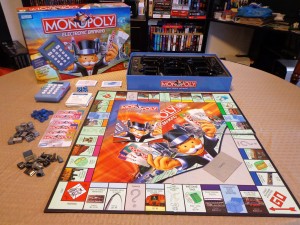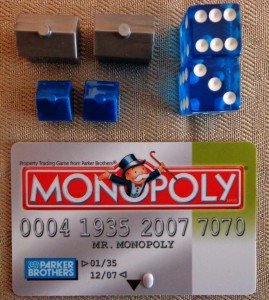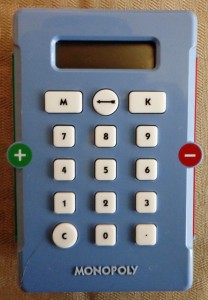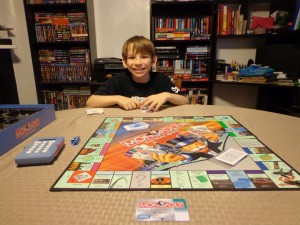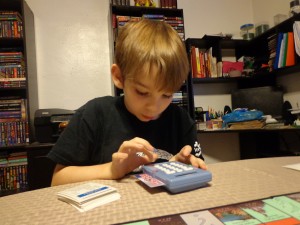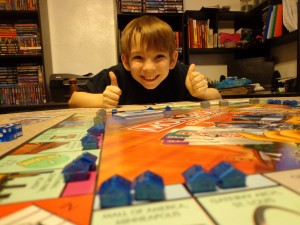“Monopoly” has been around for quite some time. While many variations of the board game exist that keep with the main theme, “Monopoly: Electronic Banking Edition” was one of the first editions to drastically change how the game was played. Let’s take a quick look at how this game is different from the base game and whether or not it’s worth picking up.
Components
The components in this edition are fairly similar to the standard game, though there are a few unique additions that set this game apart. For one, this game includes an electronic banking unit, which is similar to the debit/credit card readers you’d find at your local store when in the checkout isle. To go along with that are six Monopoly bank cards that come in different player colors. It should be noted that the electronic banking unit requires two tripple-A batteries, so be sure to have some on hand before playing!
Besides the electronic banking unit and bank cards, all of the other components look and function the same way. You’ll have your deed cards, community chest & chance cards, houses & hotels, game pieces, and etc. The board spaces and player pieces are slightly different in that they are more current with the times, but everything is still where it should be and where you’d expect to find it.
Setup & Gameplay
First, one player is assigned the role of the banker, who is in charge of dishing out and taking away money, deeds, and houses whenever appropriate. They also head up auctions, should the players agree to include them in their game experience. Next, the community chest and chance cards are shuffled and placed on the game board. Finally, each player receives a bank card (each card should have $15M) and a game piece of their choice. The game pieces are placed on “Go” and a starting player is determined via a dice roll.
Like in regular Monopoly, dice are rolled to move the game pieces along the board. Players take the appropriate action on their turn based on the spaces in which they land. Properties start out as unowned and can be purchased by the players who land on them. Once a player owns a property, they receive rent money from another player who happens to land on it. In this particular version, both cards are inserted into the reader with the landlord’s card being placed on the green plus side and the renter’s card being placed on the red minus side. The value of the rent is typed into the keypad and the balances are adjusted on the accounts involved.
The same process is done when doing anything that involves losing or receiving money. Players place their card on the minus side of the reader when buying property, paying fees/dues, and other situations that result in a loss. Likewise, players who receive funds will be placing their card on the plus side of the reader and type in the appropriate value to receive on their account.
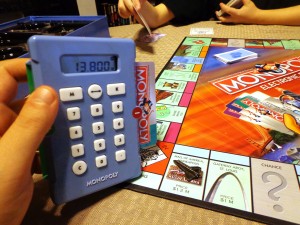
Placing the card in either reader will show you the account balance. Be sure to note it before buying property!
Players will be buying property and trading with each other in the hopes of forming a monopoly, which is when they acquire the deeds to all of the properties of one color. This allows them to place houses and hotels on said properties (at cost), which increase their value and how much rent another player pays when they land on them. Gameplay continues until one player is left standing…that is, whoever doesn’t go bankrupt. This person, for obvious reasons, is the winner!
The above doesn’t cover all of the rules, but gives you an idea of how the game is played. For more information, you can check out the manual, which is located here:
Monopoly: Electronic Banking Edition Manual
The Review
I’ll be honest, I was skeptical of this version. I thought it was just another edition designed to appeal to a particular crowd with the intent on taking my money. In a way it still is, as the rules are generally the same. What truly separates this game from the standard edition is the electronic banking aspect, which I found to be a real time-saver, all things considered.
The electronic banking version is much “cleaner” and doesn’t freak my OCD out as much. Money isn’t flying all over the place and people don’t argue over who gave who what in terms of physical play money. The downside to this mechanic is that the kids are encouraged to be lazy in that they don’t need to figure out the math behind the transactions, though I solve this by asking them to “check the computer’s work” before a transaction is done.
The components themselves are sharp; I particularly like the blue hues of the dice and houses. The electronic banking device is easy to use and fairly self-explanatory. The “M” and “K” keys help to make entering high or low amounts easy, and the “Go” key helps to keep the process of awarding “Go” money from getting monotonous. Holding the “C” key resets the game, making cleanup easy…though between that and the battery, players run the risk of losing all of their data on a whim. The box insert functions well in that it isn’t difficult to extract or insert the components.
The kids always get a kick out of playing this game, mainly because they enjoy sliding their bank card into the reader and punching in amounts. They watch their dad do it every time we go grocery shopping and I suppose playing with fake credit cards is the equivalent of playing with play money…something I did when I was a kid. They often buy up everything they can and I forgo the auction process when I play with them, mainly because Vinnie (11) isn’t at that level of fully understanding them yet. While player trading is an important part of Monopoly, I find it important for parents to mediate when younger kids are involved as they often make questionable deals that would serve to set them back.
Is it worth picking up? I suppose that is the $26.99 question (depending on where you shop for it). The regular edition of Monopoly will give you the same play experience when it comes to strategies, buying up properties, and being sent to jail every other turn (that is, if you have my luck). Free, online versions of Monopoly provide a cleaner and convenient play experience, though there is something to be said for sitting down with your family and physically playing a board game as opposed to playing a video game.
Overall, “Monopoly: Electronic Banking Edition” is a fairly good variant to the base game, one I’d actually recommend if you’re looking to automate things but still want to have a family game night around the dining room table. Some diehard Monopoly fans may scoff at the updated variant, while collectors may find the game refreshing when compared to the other editions they might have in their closet. Either way, it’s a fun game to play and if you can find it at a good price, I’d recommend picking it up.
Final Verdict: 9/10
—

